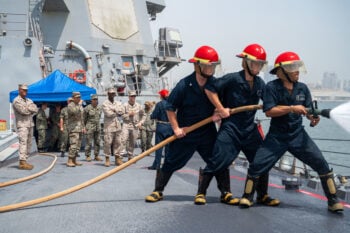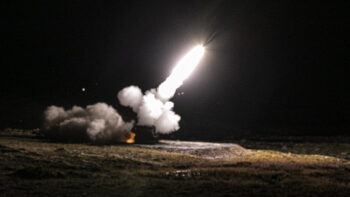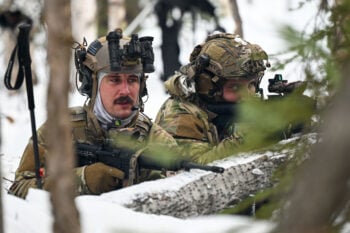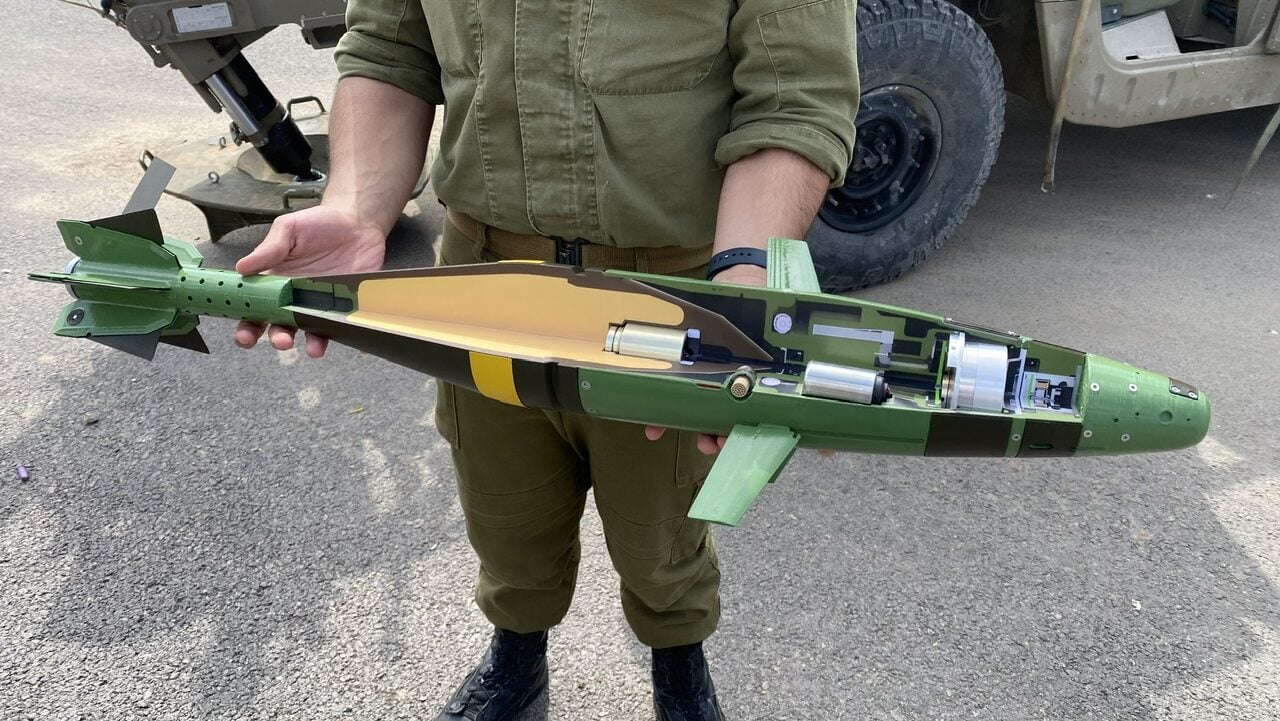
Lt. Col. Liron Cohen holds a cross-section of Israel’s Iron Sting mortar. (Seth Frantzman/Breaking Defense)
JERUSALEM — Four months into Israel’s war against Hamas in Gaza, a number of new technologies and platforms have been used by the Israel Defense Forces. Among them is the Iron Sting precision mortar, first unveiled in 2021 but not used in combat until recently.
During a visit to a military base in central Israel, Breaking Defense received a rare look at the 120mm mortar up-close, alongside Lt. Col. Liron Cohen, an IDF officer who helped develop it through the Ministry of Defense’s Directorate of Defense Research and Development.
Cohen is the head of the munitions branch in the technology division of the Technology and Logistics Directorate, which puts him in charge of “almost all ground munitions,” and was part of the development of the Iron Sting from the beginning. It was co-developed with the DDR&D and Elbit Systems. “It’s our job to make the technical specification and translate them to operational requirements and then run the project until it’s ready for operational evaluation,” Cohen said.
“This is one of a kind in the world,” Cohen said about the weapon, which the IDF says has the level of precision usually reserved for air-launched missiles – but built into the kind of mortar that every soldier can learn how to operate. That means it can be used against specific targets in the kind of complex environments the IDF is facing in Gaza, potentially forgoing the need to call in an air strike.
Operationally, the Iron String replaces the concept of mortars as a statistical weapon, where you fire a number of them near a target and hope to neutralize it, and instead turns it into a precision-guided weapon — but one that is cheaper to equip and deploy than air-launched effects.
The launcher can be mounted on a vehicle such as an M113 and a Humvee. The version seen by Breaking Defense was on a Humvee and had an intuitive and user friendly interface, with a joystick that lowers the mortar barrel so forces can quickly deploy it. The mortar is plugged into a computer on a Humvee, where the mortar’s internal system receives the data it needs for its mission. Once launched it powers up, expands guidance fins, and uses GPS and its laser seeker to fly towards it target.
The operator can also choose to have the round explode with a proximity sensor, meaning in the air just above a target, or to penetrate a target and then explode. The latter tactic be useful to penetrate a building and strike a specific room. “It can penetrate through the ceiling or wall,” Cohen said.
Cohen noted that the mortar has a failsafe: if the computer analyzes its trajectory and it is not going to hit the target, the munition is neutralized and lands as a dud. And while a dud mortar can still harm people — no one would enjoy a 16kg weight, slightly heavier than a normal 120mm round, lobbed at high speeds hitting them — the weapon won’t explode, limiting accidental damage to people and property.
Still, precision weapons are no guarantee of civilian safety. The Hamas-run Gaza Health Ministry has claimed that more than 29,000 Palestinians have been killed by Israeli strikes since the war began, while the Israeli government has claimed more than 10,000 Hamas militants have been killed.
Operations In Gaza
Elements of the Maglan special forces used the Iron Sting for the first time operationally on Sunday, Oct. 22, striking a Hamas rocket launching site. The Maglan unit has been operating with the IDF’s 98th Division, which includes paratroops and commandos, in Khan Younis since early December.
When Iron Sting was first unveiled in 2021, then-Defense Minister Benny Gantz praised it one of many technologies making the IDF more accurate and effective. It was envisioned as part of the multi-year Momentum plan that was supposed to use technology to bring more firepower more effectively to targets and close “sensor to shooter” loops for maneuvering forces.
While the Oct. 7 terrorist attacks by Hamas, and subsequent war in Gaza, have led to questions about the Momentum plan, the Iron Sting is proving itself as valuable given the very specific conditions in Gaza.
Soldiers fighting in Gaza have often said that Hamas fighters will pop out of tunnels or buildings with weapons for only a short period of time, requiring rapid response. If “we get the mission data, in less than a minute we can close the loop against the terrorist,” Cohen says, a much faster timeline than having to call in an airstrike.
Cohen said the troops have been satisfied with it and “they always ask for more.” But it’s unknown what the stockpiles of the weapon actually look like: The IDF did not provide details on the number of Iron Sting systems in use or the number of mortars fired so far with the system. The cost per unit for the munition was also not provided.
Still, it’s clear the IDF is happy to get word out about the system. In addition to giving Breaking Defense access to Cohen, official releases have called out its use several times.
The IDF has mentioned the Iron Sting several times in this war. On Nov. 23 the IDF used it against a rocket launcher. The Commando Brigade of the 98th was described as using the munition in Khan Younis on Dec. 8. It was also used against a “weapon storage compound” in Khan Younis and a launch post in Lebanon on Dec. 15. On Jan. 25 the IDF said the Egoz elite unit that is part of the 98th division and is also operating in Khan Younis, used it against terrorists.
The IDF could not elaborate on what other units the mortar has been deployed with.
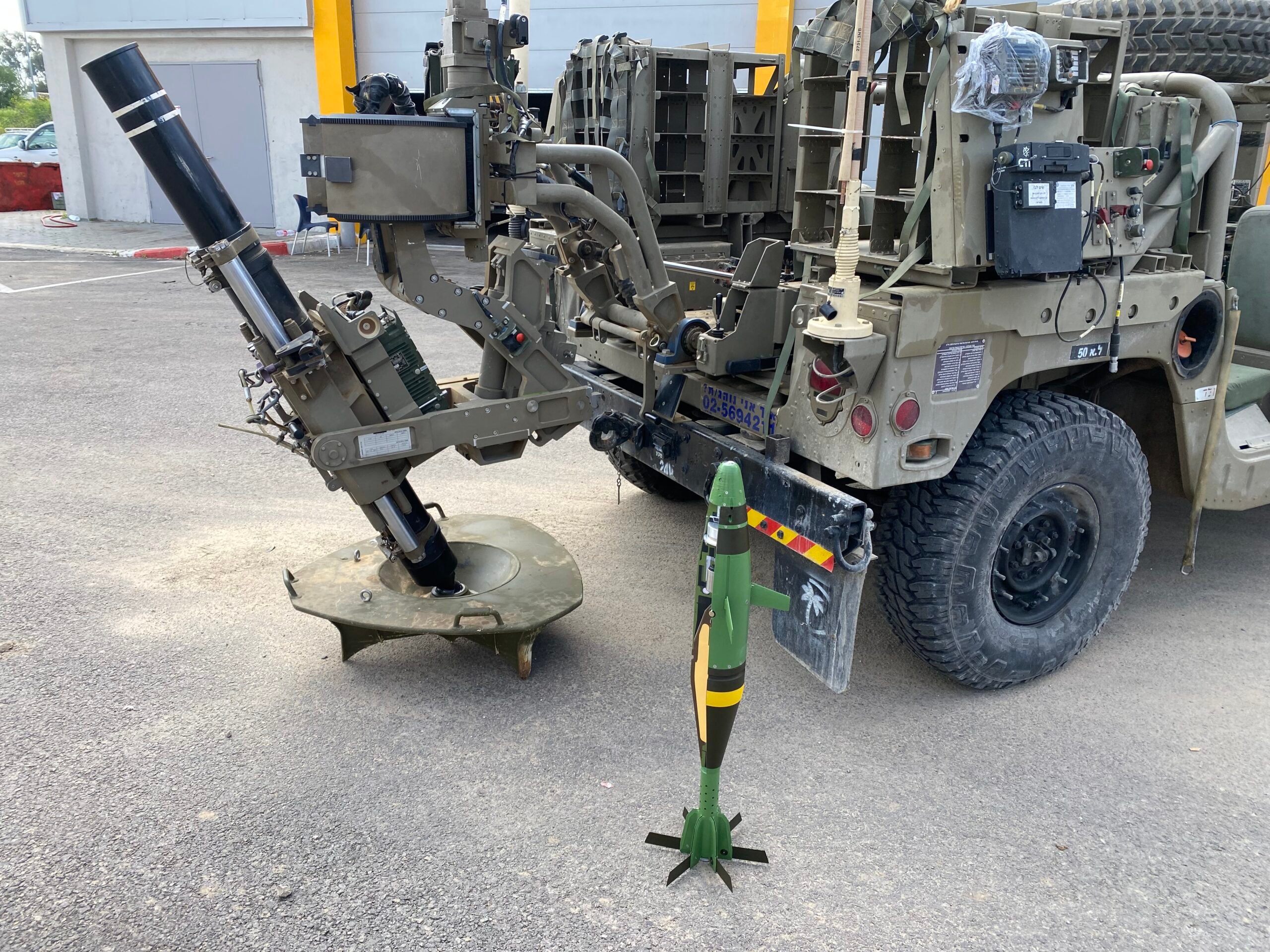
The Iron Sting mortar is seen next to a Humvee-mounted launcher. (Seth Frantzman/Breaking Defense)
Aloha: Fixes ongoing, then Army’s new watercraft prototype is Hawaii bound for testing
“Everything that we can knock off that list we will do in the archipelago…because that allows us to do the tests in the environment that the vessel will operate in ultimately,” said Maj. Gen. Jered Helwig.





















